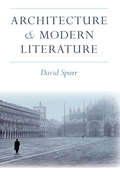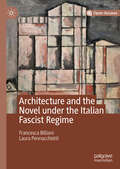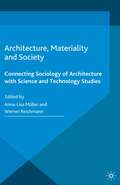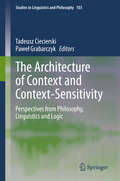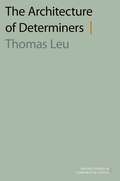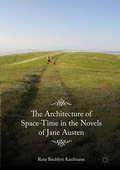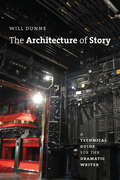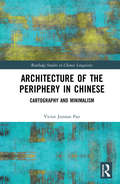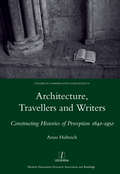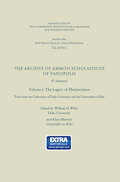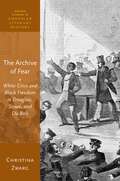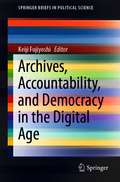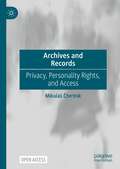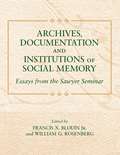- Table View
- List View
Architecture and Modern Literature
by David A SpurrArchitecture and Modern Literatureexplores the representation and interpretation of architectural space in modern literature from the early nineteenth century to the present, with the aim of showing how literary production and architectural construction are related as cultural forms in the historical context of modernity. In addressing this subject, it also examines the larger questions of the relation between literature and architecture and the extent to which these two arts define one another in the social and philosophical contexts of modernity. Architecture and Modern Literature will serve as a foundational introduction to the emerging interdisciplinary study of architecture and literature. David Spurr addresses a broad range of material, including literary, critical, and philosophical works in English, French, and German, and proposes a new historical and theoretical overview of this area, in which modern forms of "meaning" in architecture and literature are related to the discourses of being, dwelling, and homelessness.
Architecture and the Novel under the Italian Fascist Regime
by Francesca Billiani Laura PennacchiettiArchitecture and the Novel under the Italian Fascist Regime discusses the relationship between the novel and architecture during the Fascist period in Italy (1922-1943). By looking at two profoundly diverse aesthetic phenomena within the context of the creation of a Fascist State art, Billiani and Pennacchietti argue that an effort of construction, or reconstruction, was the main driving force behind both projects: the advocated “revolution” of the novel form (realism) and that of architecture (rationalism). The book is divided into seven chapters, which in turn analyze the interconnections between the novel and architecture in theory and in practice. The first six chapters cover debates on State art, on the novel and on architecture, as well as their historical development and their unfolding in key journals of the period. The last chapter offers a detailed analysis of some important novels and buildings, which have in practice realized some of the key principles articulated in the theoretical disputes.
Architecture, Materiality and Society: Connecting Sociology of Architecture with Science and Technology Studies
by Anna-Lisa Müller Werner ReichmannThis book examines the extent to which the insights of STS can be used to analyse the role of architecture in and for social life. The contributions examine the question of whether architecture and thus materiality as a whole has agency. The book also proposes a theoretical and methodological approach on how to research architecture's agency.
The Architecture of Context and Context-Sensitivity: Perspectives from Philosophy, Linguistics and Logic (Studies in Linguistics and Philosophy #103)
by Tadeusz Ciecierski Paweł GrabarczykThis volume addresses foundational issues of context-dependence and indexicality, which are at the center of the current debate within the philosophy of language. Topics include the scope of context-dependency, the nature of content and the character of input data of cognitive processes relevant for the interpretation of utterances. There's also coverage of the role of beliefs and intentions as contextual factors, as well as the validity of arguments in context-sensitive languages.The contributions consider foundational issues regarding context-sensitivity from three different, yet related, perspectives on the phenomenon of context-dependence: representational, structural, and functional. The contributors not only address the representational, structural and/or functional problems separately but also study their mutual connections, thus furthering the debate and bringing competing approaches closer to unification and consensus. This text appeals to students and researchers within the field.This is a very useful collection of essays devoted to the roles of context in the study of language. Its essays provide a useful overview of the current debates on this topic, and they put forth novel contributions that will undoubtedly be of relevance for the development of all areas in philosophy and linguistics interested in the notion of context. Stefano Predelli Department of Philosophy, University of Nottingham, Nottingham, UK
The Architecture of Determiners (Oxford Studies in Comparative Syntax)
by Thomas LeuWork in morphology is typically concerned with productive word formation and regular inflection, in any event with open class categories such as verbs, nouns, and adjectives, and their various forms. The Architecture of Determiners, by contrast, is devoted to a set of function words: the closed class of determiners. While it is traditionally assumed that function words are syntactically atomic, Thomas Leu shows that a comparative perspective on a series of determiners - each insistently vivisected into its minimal morphotactic segments - reveals an anatomy with properties analogous to clausal syntax, including a lexical, an inflectional, and left peripheral layer, as well as transformational relations among subconstituents. Leu argues that determiners are extended adjectival projections with a closed class minimal stem. Leu focuses on Swiss German and German, using other Germanic and non-Germanic languages as a comparative domain. His discussion of the internal structure of determiners includes demonstratives (ch.2), distributive quantifiers (ch.4), possessive and negative determiners (ch.5), and interrogative determiners such as 'was für' (ch.6). His main claim - that all of these involve extended adjectival projections - connects naturally to a discussion of adjectival / determiner inflection in German. Chapter 3 addresses the oft-debated strong versus weak agreement alternation in a novel way, proposing that the adjective moves within its own extended projection, in a way akin to verb movement to C in the clause. This accounts for the central facts of nominative and accusative inflection. Chapter 7, then, addresses dative and genitive morphology, setting them syntactically apart from adjectival / determiner inflection in a way that leads to a surprising account of most of the systematic (meta-) syncretism patterns in German adjectival inflection.
The Architecture of Space-Time in the Novels of Jane Austen
by Ruta Baublyté KaufmannThis book argues that there are recurrent spatiotemporal patterns and structures in six Jane Austen novels which constitute a source of enduring, if unconscious, pleasure. More precisely, the book contends that there are overlapping natural and cultural cycles which co-exist in a constantly transmuting space-time and which are counterpointed with the linearity of pivotal events that drive the plot forwards. This work examines the psychological relations to these space-time patterns of the characters, principally the heroines, focusing on the transformations of their emotional states which prompt linear leaps.
The Architecture of Space-Time in the Novels of Jane Austen
by Ruta Baublyté KaufmannThis book argues that there are recurrent spatiotemporal patterns and structures in six Jane Austen novels which constitute a source of enduring, if unconscious, pleasure. More precisely, the book contends that there are overlapping natural and cultural cycles which co-exist in a constantly transmuting space-time and which are counterpointed with the linearity of pivotal events that drive the plot forwards. This work examines the psychological relations to these space-time patterns of the characters, principally the heroines, focusing on the transformations of their emotional states which prompt linear leaps.
The Architecture of Story: A Technical Guide for the Dramatic Writer (Chicago Guides to Writing, Editing, and Publishing)
by Will DunneWhile successful plays tend to share certain storytelling elements, there is no single blueprint for how a play should be constructed. Instead, seasoned playwrights know how to select the right elements for their needs and organize them in a structure that best supports their particular story. Through his workshops and book The Dramatic Writer’s Companion, Will Dunne has helped thousands of writers develop successful scripts. Now, in The Architecture of Story, he helps writers master the building blocks of dramatic storytelling by analyzing a trio of award-winning contemporary American plays: Doubt: A Parable by John Patrick Shanley, Topdog/Underdog by Suzan-Lori Parks, and The Clean House by Sarah Ruhl. Dismantling the stories and examining key components from a technical perspective enables writers to approach their own work with an informed understanding of dramatic architecture. Each self-contained chapter focuses on one storytelling component, ranging from “Title” and “Main Event” to “Emotional Environment” and “Crisis Decision.” Dunne explores each component in detail, demonstrating how it has been successfully handled in each play and comparing and contrasting techniques. The chapters conclude with questions to help writers evaluate and improve their own scripts. The result is a nonlinear reference guide that lets writers work at their own pace and choose the topics that interest them as they develop new scripts. This flexible, interactive structure is designed to meet the needs of writers at all stages of writing and at all levels of experience.
The Architecture of Story: A Technical Guide for the Dramatic Writer (Chicago Guides to Writing, Editing, and Publishing)
by Will DunneWhile successful plays tend to share certain storytelling elements, there is no single blueprint for how a play should be constructed. Instead, seasoned playwrights know how to select the right elements for their needs and organize them in a structure that best supports their particular story. Through his workshops and book The Dramatic Writer’s Companion, Will Dunne has helped thousands of writers develop successful scripts. Now, in The Architecture of Story, he helps writers master the building blocks of dramatic storytelling by analyzing a trio of award-winning contemporary American plays: Doubt: A Parable by John Patrick Shanley, Topdog/Underdog by Suzan-Lori Parks, and The Clean House by Sarah Ruhl. Dismantling the stories and examining key components from a technical perspective enables writers to approach their own work with an informed understanding of dramatic architecture. Each self-contained chapter focuses on one storytelling component, ranging from “Title” and “Main Event” to “Emotional Environment” and “Crisis Decision.” Dunne explores each component in detail, demonstrating how it has been successfully handled in each play and comparing and contrasting techniques. The chapters conclude with questions to help writers evaluate and improve their own scripts. The result is a nonlinear reference guide that lets writers work at their own pace and choose the topics that interest them as they develop new scripts. This flexible, interactive structure is designed to meet the needs of writers at all stages of writing and at all levels of experience.
The Architecture of Story: A Technical Guide for the Dramatic Writer (Chicago Guides to Writing, Editing, and Publishing)
by Will DunneWhile successful plays tend to share certain storytelling elements, there is no single blueprint for how a play should be constructed. Instead, seasoned playwrights know how to select the right elements for their needs and organize them in a structure that best supports their particular story. Through his workshops and book The Dramatic Writer’s Companion, Will Dunne has helped thousands of writers develop successful scripts. Now, in The Architecture of Story, he helps writers master the building blocks of dramatic storytelling by analyzing a trio of award-winning contemporary American plays: Doubt: A Parable by John Patrick Shanley, Topdog/Underdog by Suzan-Lori Parks, and The Clean House by Sarah Ruhl. Dismantling the stories and examining key components from a technical perspective enables writers to approach their own work with an informed understanding of dramatic architecture. Each self-contained chapter focuses on one storytelling component, ranging from “Title” and “Main Event” to “Emotional Environment” and “Crisis Decision.” Dunne explores each component in detail, demonstrating how it has been successfully handled in each play and comparing and contrasting techniques. The chapters conclude with questions to help writers evaluate and improve their own scripts. The result is a nonlinear reference guide that lets writers work at their own pace and choose the topics that interest them as they develop new scripts. This flexible, interactive structure is designed to meet the needs of writers at all stages of writing and at all levels of experience.
The Architecture of Story: A Technical Guide for the Dramatic Writer (Chicago Guides to Writing, Editing, and Publishing)
by Will DunneWhile successful plays tend to share certain storytelling elements, there is no single blueprint for how a play should be constructed. Instead, seasoned playwrights know how to select the right elements for their needs and organize them in a structure that best supports their particular story. Through his workshops and book The Dramatic Writer’s Companion, Will Dunne has helped thousands of writers develop successful scripts. Now, in The Architecture of Story, he helps writers master the building blocks of dramatic storytelling by analyzing a trio of award-winning contemporary American plays: Doubt: A Parable by John Patrick Shanley, Topdog/Underdog by Suzan-Lori Parks, and The Clean House by Sarah Ruhl. Dismantling the stories and examining key components from a technical perspective enables writers to approach their own work with an informed understanding of dramatic architecture. Each self-contained chapter focuses on one storytelling component, ranging from “Title” and “Main Event” to “Emotional Environment” and “Crisis Decision.” Dunne explores each component in detail, demonstrating how it has been successfully handled in each play and comparing and contrasting techniques. The chapters conclude with questions to help writers evaluate and improve their own scripts. The result is a nonlinear reference guide that lets writers work at their own pace and choose the topics that interest them as they develop new scripts. This flexible, interactive structure is designed to meet the needs of writers at all stages of writing and at all levels of experience.
The Architecture of Story: A Technical Guide for the Dramatic Writer (Chicago Guides to Writing, Editing, and Publishing)
by Will DunneWhile successful plays tend to share certain storytelling elements, there is no single blueprint for how a play should be constructed. Instead, seasoned playwrights know how to select the right elements for their needs and organize them in a structure that best supports their particular story. Through his workshops and book The Dramatic Writer’s Companion, Will Dunne has helped thousands of writers develop successful scripts. Now, in The Architecture of Story, he helps writers master the building blocks of dramatic storytelling by analyzing a trio of award-winning contemporary American plays: Doubt: A Parable by John Patrick Shanley, Topdog/Underdog by Suzan-Lori Parks, and The Clean House by Sarah Ruhl. Dismantling the stories and examining key components from a technical perspective enables writers to approach their own work with an informed understanding of dramatic architecture. Each self-contained chapter focuses on one storytelling component, ranging from “Title” and “Main Event” to “Emotional Environment” and “Crisis Decision.” Dunne explores each component in detail, demonstrating how it has been successfully handled in each play and comparing and contrasting techniques. The chapters conclude with questions to help writers evaluate and improve their own scripts. The result is a nonlinear reference guide that lets writers work at their own pace and choose the topics that interest them as they develop new scripts. This flexible, interactive structure is designed to meet the needs of writers at all stages of writing and at all levels of experience.
The Architecture of Story: A Technical Guide for the Dramatic Writer (Chicago Guides to Writing, Editing, and Publishing)
by Will DunneWhile successful plays tend to share certain storytelling elements, there is no single blueprint for how a play should be constructed. Instead, seasoned playwrights know how to select the right elements for their needs and organize them in a structure that best supports their particular story. Through his workshops and book The Dramatic Writer’s Companion, Will Dunne has helped thousands of writers develop successful scripts. Now, in The Architecture of Story, he helps writers master the building blocks of dramatic storytelling by analyzing a trio of award-winning contemporary American plays: Doubt: A Parable by John Patrick Shanley, Topdog/Underdog by Suzan-Lori Parks, and The Clean House by Sarah Ruhl. Dismantling the stories and examining key components from a technical perspective enables writers to approach their own work with an informed understanding of dramatic architecture. Each self-contained chapter focuses on one storytelling component, ranging from “Title” and “Main Event” to “Emotional Environment” and “Crisis Decision.” Dunne explores each component in detail, demonstrating how it has been successfully handled in each play and comparing and contrasting techniques. The chapters conclude with questions to help writers evaluate and improve their own scripts. The result is a nonlinear reference guide that lets writers work at their own pace and choose the topics that interest them as they develop new scripts. This flexible, interactive structure is designed to meet the needs of writers at all stages of writing and at all levels of experience.
Architecture of the Periphery in Chinese: Cartography and Minimalism (Routledge Studies in Chinese Linguistics)
by Victor Junnan PanArchitecture of the Periphery in Chinese offers a comprehensive survey on the fine structure of the sentence peripheral domain in Mandarin Chinese from a cartographic perspective. Different functional projections hosting sentence-final particles, implicit operators and other informational components are hierarchically ordered according to the "Subjectivity Scale Constraint" functioning at syntax-discourse interface. Three questions will be essentially addressed: What is the order? How to determine such an order? Why such an order? This research not only gives a thorough examination of the peripheral elements in Chinese but also improves the general understanding of the ordering issue in the left-periphery crosslinguistically. This book is aimed at scholars interested in Chinese syntax or generative syntax.
Architecture of the Periphery in Chinese: Cartography and Minimalism (Routledge Studies in Chinese Linguistics)
by Victor Junnan PanArchitecture of the Periphery in Chinese offers a comprehensive survey on the fine structure of the sentence peripheral domain in Mandarin Chinese from a cartographic perspective. Different functional projections hosting sentence-final particles, implicit operators and other informational components are hierarchically ordered according to the "Subjectivity Scale Constraint" functioning at syntax-discourse interface. Three questions will be essentially addressed: What is the order? How to determine such an order? Why such an order? This research not only gives a thorough examination of the peripheral elements in Chinese but also improves the general understanding of the ordering issue in the left-periphery crosslinguistically. This book is aimed at scholars interested in Chinese syntax or generative syntax.
Architecture, Travellers and Writers: Constructing Histories of Perception 1640-1950
by Anne HultzschDoes the way in which buildings are looked at, and made sense of, change over the course of time? How can we find out about this? By looking at a selection of travel writings spanning four centuries, Anne Hultzsch suggests that it is language, the description of architecture, which offers answers to such questions. The words authors use to transcribe what they see for the reader to re-imagine offer glimpses at modes of perception specific to one moment, place and person. Hultzsch constructs an intriguing patchwork of local and often fragmentary narratives discussing texts as diverse as the 17th-century diary of John Evelyn, Daniel Defoe's Robinson Crusoe (1719) and an 1855 art guide by Swiss art historian Jacob Burckhardt. Further authors considered include 17th-century collector John Bargrave, 18th-century novelist Tobias Smollett, poet Johann Wolfgang von Goethe, critic John Ruskin as well as the 20th-century architectural historian Nikolaus Pevsner. Anne Hultzsch teaches at the Bartlett School of Architecture, University College London.
Architecture, Travellers and Writers: Constructing Histories of Perception 1640-1950
by Anne HultzschDoes the way in which buildings are looked at, and made sense of, change over the course of time? How can we find out about this? By looking at a selection of travel writings spanning four centuries, Anne Hultzsch suggests that it is language, the description of architecture, which offers answers to such questions. The words authors use to transcribe what they see for the reader to re-imagine offer glimpses at modes of perception specific to one moment, place and person. Hultzsch constructs an intriguing patchwork of local and often fragmentary narratives discussing texts as diverse as the 17th-century diary of John Evelyn, Daniel Defoe's Robinson Crusoe (1719) and an 1855 art guide by Swiss art historian Jacob Burckhardt. Further authors considered include 17th-century collector John Bargrave, 18th-century novelist Tobias Smollett, poet Johann Wolfgang von Goethe, critic John Ruskin as well as the 20th-century architectural historian Nikolaus Pevsner. Anne Hultzsch teaches at the Bartlett School of Architecture, University College London.
Architekturen des Unheimlichen: Kinetische Labyrinthe des Horrors in Film und Literatur (Lettre)
by Marlen FreimuthIn welchem Spannungsfeld stehen Unheimliches und Architektur in Büchern, Comics oder Filmen? Marlen Freimuth identifiziert Architekturen des Unheimlichen als Architektouren: Es handelt sich um Architekturen, die einerseits die Signatur des Unheimlichen tragen und andererseits und zugleich um Architekturen, die das Unheimliche in, mit und durch seine Bewegung, Bewegtheit und Beweglichkeit errichtet. Architekturen des Unheimlichen konstellieren sich so als labyrinthische Konstruktionen, deren räumliche Struktur oszilliert und die nie mit sich identisch sein werden. Mithilfe eines psychoanalytischen Begriffskatalogs, der diese spezifischen Modalitäten signifiziert, gilt die Analyse konkreten Beispielen in Werken wie Danielewskis »House of Leaves« oder Vincenzo Natalis »Cube«.
Architextual Authenticity: Constructing Literature and Literary Identity in the French Caribbean (Contemporary French and Francophone Cultures #47)
by Jason HerbeckConstruction of identity has constituted a vigorous source of debate in the Caribbean from the early days of colonization to the present, and under the varying guises of independence, departmentalization, dictatorship, overseas collectivity and occupation. Given the strictures and structures of colonialism long imposed upon the colonized subject, the (re)makings of identity have proven anything but evident when it comes to determining authentic expressions and perceptions of the postcolonial self. By way of close readings of both constructions in literature and the construction of literature, Architextual Authenticity: Constructing Literature and Literary Identity in the French Caribbean proposes an original, informative frame of reference for understanding the long and ever-evolving struggle for social, cultural, historical and political autonomy in the region. Taking as its point of focus diverse canonical and lesser-known texts from Guadeloupe, Martinique and Haiti published between 1958 and 2013, this book examines the trope of the house (architecture) and the meta-textual construction of texts (architexture) as a means of conceptualizing and articulating how authentic means of expression are and have been created in French-Caribbean literature over the greater part of the past half-century—whether it be in the context of the years leading up to or following the departmentalization of France’s overseas colonies in the 1940’s, the wrath of Hurricane Hugo in 1989, or the devastating Haiti earthquake of 2010.
The Archive of Ammon Scholasticus of Panopolis: The Legacy of Harpocration (Abhandlungen der Nordrhein-Westfälischen Akademie der Wissenschaften #26/1)
by William H. Willis Klaus MareschThe Archive of Fear: White Crisis and Black Freedom in Douglass, Stowe, and Du Bois (Oxford Studies in American Literary History)
by Christina ZwargFocusing on U.S. slavery and its aftermath in the nineteenth century, The Archive of Fear explores the traumatic force field that continued to inflect discussions of slavery and abolition both before and after the Civil War. It challenges the long-assumed distinction between psychological and cultural-historical theories of trauma, discovering a virtual dialogue between three central U. S. writers and Sigmund Freud concerning the traumatic response of slavery's perpetrators. A strain of trauma theory and practice comes alive in the temporal and spatial disruptions of New World slavery-and The Archive of Fear shows how key elements of that theory still inform the infrastructure of race relations today. It argues that trauma theory before Freud first involves a return to an overlap between crisis, insurrection, and mesmerism found in the work of Frederick Douglass, Harriet Beecher Stowe, and W. E. B. Du Bois. Mesmer's "crisis state" has long been read as the precursor to hypnosis, the tool Freud famously rejected when he created psychoanalysis. But the story of what was lost to trauma theory when Freud adopted the "talk cure" can be told through cultural disruptions of New World slavery, especially after mesmerism arrived in Saint Domingue where its implication in the Haitian revolution in both reality and fantasy had an impact on the history of emancipation in the United States.
The Archive of Fear: White Crisis and Black Freedom in Douglass, Stowe, and Du Bois (Oxford Studies in American Literary History)
by Christina ZwargFocusing on U.S. slavery and its aftermath in the nineteenth century, The Archive of Fear explores the traumatic force field that continued to inflect discussions of slavery and abolition both before and after the Civil War. It challenges the long-assumed distinction between psychological and cultural-historical theories of trauma, discovering a virtual dialogue between three central U. S. writers and Sigmund Freud concerning the traumatic response of slavery's perpetrators. A strain of trauma theory and practice comes alive in the temporal and spatial disruptions of New World slavery-and The Archive of Fear shows how key elements of that theory still inform the infrastructure of race relations today. It argues that trauma theory before Freud first involves a return to an overlap between crisis, insurrection, and mesmerism found in the work of Frederick Douglass, Harriet Beecher Stowe, and W. E. B. Du Bois. Mesmer's "crisis state" has long been read as the precursor to hypnosis, the tool Freud famously rejected when he created psychoanalysis. But the story of what was lost to trauma theory when Freud adopted the "talk cure" can be told through cultural disruptions of New World slavery, especially after mesmerism arrived in Saint Domingue where its implication in the Haitian revolution in both reality and fantasy had an impact on the history of emancipation in the United States.
Archives, Accountability, and Democracy in the Digital Age (SpringerBriefs in Political Science)
by Keiji FujiyoshiThis book is the first attempt to introduce the current status of archival practices in Japan as well as the basic views of the populace on making records accessible to English readers. In general, Japan has not paid sufficient attention to keeping and utilizing records except in the field of historical research. This book thus examines Japanese attitudes about history, records management, information acts, the status of archivists of the constitution, and genealogical research practices and a description of archives. Consequently, such investigations clarify how both private and public archives function or fail to do so in those spheres of Japanese society. In addition, this book presents the efforts in wartime record keeping in Australia, which is significantly different from how the Japanese deal with such records. This book therefore provides a clear and concrete picture of the status of current archival practices in Japan and the thinking that underlies them. On the basis of such examinations, this book enables readers to understand to what extent and how the past affects the present through archives, to recognize the importance of archives, and to respect the past in order to maintain and develop perspectives in people’s lives.
Archives and Records: Privacy, Personality Rights, and Access
by Mikuláš ČtvrtníkThis open access book addresses the protection of privacy and personality rights in public records, records management, historical sources, and archives; and historical and current access to them in a broad international comparative perspective. Considering the question “can archiving pose a security risk to the protection of sensitive data and human rights?”, it analyses data security and presents several significant cases of the misuse of sensitive personal data, such as census data or medical records. It examines archival inflation and the minimisation and reduction of data in public records and archives, including data anonymisation and pseudonymisation, and the risks of deanonymisation and reidentification of persons. The book looks at post-mortem privacy protection, the relationship of the right to know and the right to be forgotten and introduces a specific model of four categories of the right to be forgotten. In its conclusion, the book presents a set of recommendations for archives and records management.
Archives, Documentation, and Institutions of Social Memory: Essays from the Sawyer Seminar
by Francis X. Blouin William G. RosenbergAs sites of documentary preservation rooted in various national and social contexts, artifacts of culture, and places of uncovering, archives provide tangible evidence of memory for individuals, communities, and states, as well as defining memory institutionally within prevailing political systems and cultural norms. By assigning the prerogatives of record keeper to the archivist, whose acquisition policies, finding aids, and various institutionalized predilections mediate between scholarship and information, archives produce knowledge, legitimize political systems, and construct identities. Far from being mere repositories of data, archives actually embody the fragments of culture that endure as signifiers of who we are, and why. The essays in Archives, Documentation, and Institutions of Social Memory conceive of archives not simply as historical repositories but as a complex of structures, processes, and epistemologies situated at a critical point of the intersection between scholarship, cultural practices, politics, and technologies.
